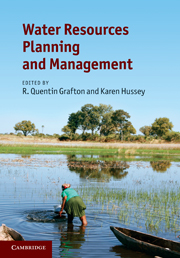Book contents
- Frontmatter
- Contents
- List of contributors
- Foreword
- Preface
- Acknowledgements
- Introduction
- Part I Understanding ‘water’
- Part II Water resources planning and management
- 8 Water law and the search for sustainability: a comparative analysis
- 9 Tackling the global water crisis: unlocking international law as fundamental to the peaceful management of the world's shared transboundary waters – introducing the H2O paradigm
- 10 Risk and uncertainty in water resources planning and management: a basic introduction
- 11 Collaboration and stakeholder engagement
- 12 Capacity building and knowledge sharing
- 13 Adaptive and integrated management of water resources
- 14 Gender and integrated water resource management
- 15 Environmental flows: achieving ecological outcomes in variable environments
- Part III Water resources planning and management: case studies
- Contributors
- Index
- References
11 - Collaboration and stakeholder engagement
from Part II - Water resources planning and management
Published online by Cambridge University Press: 05 August 2011
- Frontmatter
- Contents
- List of contributors
- Foreword
- Preface
- Acknowledgements
- Introduction
- Part I Understanding ‘water’
- Part II Water resources planning and management
- 8 Water law and the search for sustainability: a comparative analysis
- 9 Tackling the global water crisis: unlocking international law as fundamental to the peaceful management of the world's shared transboundary waters – introducing the H2O paradigm
- 10 Risk and uncertainty in water resources planning and management: a basic introduction
- 11 Collaboration and stakeholder engagement
- 12 Capacity building and knowledge sharing
- 13 Adaptive and integrated management of water resources
- 14 Gender and integrated water resource management
- 15 Environmental flows: achieving ecological outcomes in variable environments
- Part III Water resources planning and management: case studies
- Contributors
- Index
- References
Summary
Introduction and background
This chapter examines how stakeholder processes and collaborative approaches can be applied to water resources projects. Following some background information and definitions, the chapter explores specific methods and techniques for stakeholder work, relying on an in-depth case study (the Water Forum in the region surrounding Sacramento, California) to illustrate concepts, techniques, and outcomes.
Why stakeholder engagement is essential
Current trends in water management argue for a more collaborative and stakeholder-driven approach than has been used in the past. Integrated water management plans that rely on multiple sources of supply require the cooperation of various agencies and communities beyond the boundaries of any one water provider. Water management programs, like conjunctive use of surface and ground water, integrate multiple water rights, private land owners, and regulatory agencies to achieve a solution. Requirements to identify and analyse environmental effects and third-party impacts of water management decisions bring in diverse interests and issues. Seeking projects that offer multiple benefits – like flood control, habitat restoration and groundwater recharge – add to the mix of partners and potential conflicts that may arise. Watershed or catchment plans in diverse landscapes require voluntary cooperation of dozens of stakeholders and organisations. And the ever-present threat of litigation or costly political rancor looms large in the complex world of water resources. Interdependence is indeed the wave of the present.
- Type
- Chapter
- Information
- Water Resources Planning and Management , pp. 251 - 273Publisher: Cambridge University PressPrint publication year: 2011
References
- 4
- Cited by

